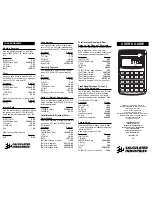
then
[2]
m
=
d
dx
f(x)
x
x
=
a
and if f(a) = b, we find n with
[3]
n
=
b
−
m
$
a
The tangent line is the first-order Taylor series polynomial at x = a, so we can use the built-in taylor()
function to find the line equation. The syntax for taylor() is
taylor(expr, var, order [,point])
where expr is the expression, var is the indpendent variable, order is the polynomial order, and the
optional point argument is the point at which to find the series expansion. To find the tangent line, we
set order = 1 and point = a. For example, if
y
=
2
$
x2
−
7
$
x
+
1
and we want to find the tangent line at x = 3, then use
taylor(2*x^2-7*x+
1
,x,
1
,3)
which returns 5(x - 3) - 2. Use expand() on this result to put it in the more common form of 5x - 17.
We can also use this method to find symbolic results. For example, suppose
y
=
ln x2
and we want to find the tangent line at x = a, then use
expand(taylor(ln(x^2),x,
1
,a))
which returns
2
$
x
a
+
ln a2
−
2
This method fails if the CAS cannot find the Taylor polynomial for the expression. This is the case for
complicated user-defined functions. In this case, you can find the derivative numerically (see, for
example, tip 6.26), then solve for the tangent line constant with equation [3] above.
[6.50] The Savage Benchmark
In March 2001 a discussion on the comp.sys.hp48 news group examined the Savage benchmark and
the performance of various HP and TI calculators with that benchmark. In this tip I describe that
benchmark, and summarize some test results provided by HP and TI users. More importantly, I offer
some opinion as to why benchmarks are fairly silly, particularly one as simple-minded as the Savage
benchmark.
A benchmark is a program intended to measure some attribute of a computer. The attribute may be
accuracy, execution time, code compactness or efficiency, or cost. Most generally, benchmark users
want to compare the performance of two or more computers, with the net result being an evaluation as
to which is the 'best' computer in terms of what the benchmark measures.
For perspective, Eric S. Raymond offers this definition in The Jargon Lexicon
6 - 83
Summary of Contents for TI-92+
Page 52: ...Component side of PCB GraphLink I O connector detail 1 41...
Page 53: ...LCD connector detail PCB switch side 1 42...
Page 54: ...Key pad sheet contact side Key pad sheet key side 1 43...
Page 55: ...Key cap detail 1 44...
Page 57: ...Component side of PCB with shield removed A detail view of the intergrated circuits 1 46...
Page 410: ...void extensionroutine2 void Credit to Bhuvanesh Bhatt 10 4...
















































